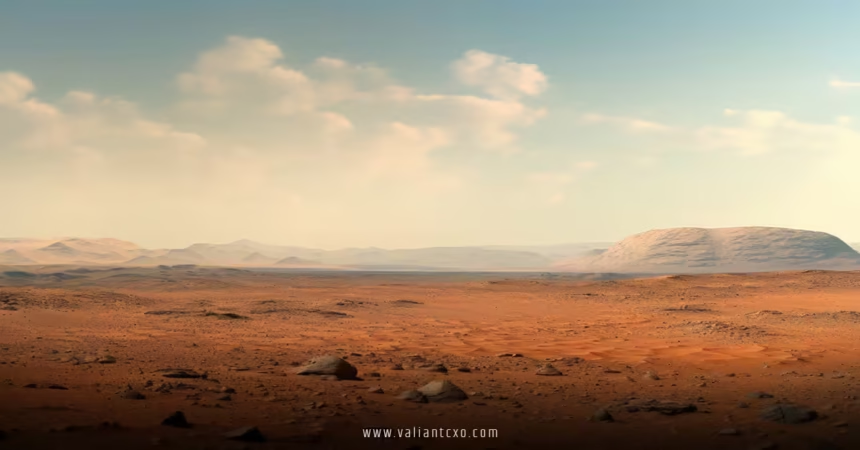NASA evidence of microbial life on Mars has captivated scientists and dreamers alike for decades, sparking endless debates about whether we’re truly alone in the universe. Picture this: a rusty rover trundling across a barren landscape, its instruments humming as they sniff out clues buried in ancient rocks. Could these hints point to tiny, long-extinct bugs that once called the Red Planet home? As someone who’s followed space exploration like a kid chasing shooting stars, I can tell you this topic keeps me up at night, pondering the what-ifs of cosmic biology.
The Allure of NASA Evidence of Microbial Life on Mars
Let’s dive right in—why does NASA evidence of microbial life on Mars feel like the ultimate sci-fi plot twist come true? Mars, our closest planetary neighbor, wears its scars like a battle-worn warrior: vast canyons, polar ice caps, and dust storms that could swallow a city. But beneath that harsh exterior lies a story of a wetter, warmer past, one that might have cradled life as we know it. I’ve always thought of Mars as the shy sibling to Earth’s bold vibrancy, hiding secrets that NASA has been chipping away at since the 1960s.
Historical Whispers: Early Quests for Clues
Remember the Viking landers? Back in 1976, NASA dropped two robotic pioneers onto Mars’ surface, and they didn’t just take selfies—they ran experiments designed to detect life. The Labeled Release test mixed Martian soil with nutrients and watched for gas releases that could signal metabolism. Positive results popped up, exciting the team like kids finding buried treasure. But skeptics pointed to chemical reactions in the soil, not microbes. Still, some researchers, like Gilbert Levin who led the experiment, swear it was biology. It’s like tasting something sweet but wondering if it’s candy or just honey from the rocks—ambiguous, yet tantalizing.
Fast forward to 1996, and NASA evidence of microbial life on Mars took a wild turn with the ALH84001 meteorite. This chunk of Mars, ejected by an ancient impact and landing in Antarctica, contained tiny structures resembling fossilized bacteria. Electron microscope images showed worm-like shapes, and chemical signatures hinted at organic processes. The world buzzed—could this be proof? Turns out, abiotic processes like heating and fracturing could mimic those features, but it ignited the astrobiology fire that’s burning brighter today.
Why Mars? The Perfect Storm for Life’s Hunt
What makes Mars the prime suspect for harboring NASA evidence of microbial life? Think about it: billions of years ago, rivers carved valleys, lakes pooled in craters, and an atmosphere thick enough to breathe (sort of). Water is life’s elixir, and Mars had it in spades before it froze or vanished. NASA’s orbiters, like MAVEN, confirm the planet lost its magnetic shield, letting solar winds strip away the air and water. But remnants linger—subsurface ice, seasonal flows. If microbes evolved there, they’d be tough cookies, hiding in briny pockets or deep cracks, much like extremophiles on Earth thriving in boiling vents or acidic pools.
I’ve chatted with astronomers who compare Mars to a time capsule. Earth’s history got overwritten by plate tectonics and oceans, but Mars froze in place, preserving snapshots. That stasis makes every pebble a potential goldmine for NASA evidence of microbial life on Mars.
Iconic Missions Fueling NASA Evidence of Microbial Life on Mars
NASA’s rovers and landers aren’t just machines; they’re our eyes and hands on Mars, tirelessly scraping, drilling, and analyzing. Each mission builds on the last, layering clues that inch us closer to answers. Let’s break down the heavy hitters.
Viking Landers: The Pioneers’ Bold Gamble
As I mentioned, Viking 1 and 2 were trailblazers. Landing in the Chryse Planitia and Utopia Planitia regions, they scooped soil and ran three biology experiments: Gas Exchange, Labeled Release, and Pyrolytic Release. The Labeled Release was the star—radioactive nutrients fed to samples produced unexpected gases. On Earth, that screams “life!” but Mars’ perchlorates (salty oxidants) muddied the waters. NASA concluded no biology, but reanalyses in the 2010s suggest the results align better with dormant spores activated by water. It’s frustrating, right? Like finding footprints in the sand but blaming the wind.
Beyond biology, Viking imaged dry riverbeds and polar caps, proving Mars’ watery past. Those visuals alone bolstered the case for NASA evidence of microbial life on Mars.
Curiosity Rover: Sniffing Out Organics in Gale Crater
Fast-forward to 2012: Curiosity touches down in Gale Crater, a 96-mile-wide basin with a central mountain layered like a cosmic cake. This rover’s Sample Analysis at Mars (SAM) lab is a beast, vaporizing rocks to hunt organics—carbon-based molecules life’s building blocks.
In 2018, Curiosity struck gold with thiophenes, sulfur-rich organics tough enough to survive Mars’ radiation. Then, methane— that sneaky gas wafting in plumes up to 21 parts per billion. On Earth, 90% comes from microbes burping in swamps or cow guts. NASA’s detections spiked seasonally, hinting at underground sources. Could it be Martian farts from hidden life? Or geological burps? The debate rages.
By 2025, Curiosity unearthed the largest organics yet: long-chain alkanes like decane and dodecane in a drilled sample called Cumberland. These 10-12 carbon molecules resemble fatty acid fragments, potential relics of ancient biology. Imagine drilling into a 3.5-billion-year-old rock and pulling out chemistry that echoes Earth’s early soup—NASA evidence of microbial life on Mars just got juicier.
Perseverance Rover: The Latest Thrills in Jezero Crater
Enter Perseverance, landing in 2021 in Jezero Crater—a former lakebed teeming with delta sediments. This rover’s mission? Collect samples for Earth return, caching 20+ tubes of rock and soil. But in July 2024, it hit a jackpot with “Cheyava Falls,” a fist-sized rock in the Bright Angel formation.
Using PIXL and SHERLOC instruments, the team spotted “leopard spots”—enigmatic patterns of iron, phosphate, and sulfur. White calcium sulfate veins scream past water flow, while organics lurk nearby. On Earth, similar spots form via microbial energy transfers in low-oxygen sediments. Vivianite and greigite minerals? They’re linked to decaying matter and bacteria. Lead author Joel Hurowitz called it a “rich energy source for microbial metabolisms.” NASA Acting Administrator Sean Duffy hailed it as “the closest we’ve come to discovering life on Mars.”
But hold up—is this definitive NASA evidence of microbial life on Mars? Not yet. Abiotic processes can’t be ruled out, though the rock’s cool, wet history favors biology. Published in Nature, it’s peer-reviewed rigor at its best, inviting global scrutiny.
Groundbreaking Clues: Decoding NASA Evidence of Microbial Life on Mars
These discoveries aren’t isolated; they weave a tapestry of habitability. Let’s unpack the stars.
Organic Molecules: Life’s Carbon Footprint
Organics are the holy grail. Viking missed them due to harsh experiments, but Phoenix (2008) found perchlorates, explaining the false negatives. Curiosity’s 2018 haul included benzene and propane precursors—simple, but resilient. The 2025 long-chain finds suggest complex chemistry, possibly from hydrothermal vents or ponds where life brewed.
Perseverance adds carbon-rich sediments, preserved against radiation. Analogy time: These molecules are like faded love letters from Mars’ youth, hinting at biological authors without spelling it out.
Methane Mysteries: Burps from Below?
Methane’s elusiveness teases us. Curiosity’s 2019 plume was 2.5 times background levels, vanishing fast—active production? Orbital spectrometers like ExoMars Trace Gas Orbiter confirm seasonal cycles, peaking in summer. Biological sources? Methanogens, Earth microbes that thrive in Mars-like cold. Geological? Serpentinization, water-rock reactions. NASA’s models lean toward biology for the spikes, but more data’s needed. What if Mars has a subsurface biosphere, puffing gas like a hidden volcano?
Ancient Habitats: Lakes, Rivers, and Microbial Havens
Jezero’s delta? A 3.7-billion-year-old beachfront property. Perseverance’s scans reveal layered clays, ideal for trapping biosignatures. Curiosity’s Gale shows recurring lakes over eons. NASA’s evidence of microbial life on Mars thrives in these wet epochs, before the planet dried up 3 billion years ago. Rheological questions arise: Did life peak early, or persist underground?
Debates and Doubts: Scrutinizing NASA Evidence of Microbial Life on Mars
Science isn’t a fairy tale; it’s a courtroom drama. Every claim faces cross-examination.
Alternative Explanations: Chemistry vs. Biology
For Viking, perchlorates stole the show—oxidizing organics into nothing. ALH84001’s “fossils”? Contamination or inorganic crystals. Methane? Cosmic rays zapping dust. Leopard spots? Acidic fluids, not bugs. NASA’s transparent: Katie Stack Morgan stresses “extraordinary evidence” required. We use scales like CoLD to rate confidence—current biosignatures score medium, needing lab confirmation.
I’ve seen debates erupt at conferences; it’s passionate, like arguing over a blurry photo of Bigfoot. But that’s progress—ruling out fakes hones the truth.
The Scientific Consensus: Hopeful but Cautious
Most experts agree: Mars was habitable. Organics prove carbon cycles; water evidence abounds. But life? No slam-dunk. A 2023 Astrobiology report rates microbial past life as plausible (50-70% odds), present life low (under 10%). NASA’s ethos? Trust but verify. As Nicky Fox puts it, these missions deliver “exactly this type of science.”
Future Frontiers: Pursuing Deeper NASA Evidence of Microbial Life on Mars
The quest doesn’t stop. What’s next?
Upcoming Missions: Eyes on the Prize
Europa Clipper (2024 launch) scouts icy moons, but Mars gets Dragonfly (2030s) to Titan—no, wait, Mars Sample Return (MSR) is key. Launching mid-2020s, it’ll fetch Perseverance’s cache, landing 2031. Earth labs will dissect Cheyava Falls with atomic precision—PCR for DNA remnants? Mass specs for proteins?
ESCAPADE orbiters probe atmosphere; Tianwen-3 (China, 2028) joins the hunt. International collab amps trustworthiness.
Sample Return and Beyond: Answering the Big Questions
MSR could confirm NASA evidence of microbial life on Mars. Imagine: microfossils under electron microscopes, isotopes screaming biology. If positive, it rewrites textbooks; if not, we refine searches. Subsurface drills like Icebreaker aim deeper, where liquid water might lurk. Metaphorically, it’s like finally opening Pandora’s box—thrilling, with unknowns galore.
As a space enthusiast, I urge: Support these missions. They’re our bridge to the stars.
Conclusion: The Enduring Quest for NASA Evidence of Microbial Life on Mars
Wrapping it up, NASA evidence of microbial life on Mars—from Viking’s enigmatic positives to Perseverance’s leopard-spotted rock—paints a picture of a planet that once danced with possibility. Organics, methane, ancient waters: these threads suggest habitability, maybe even tiny tenants. Yet debates rage, demanding more proof. This isn’t just science; it’s humanity’s mirror, asking if life sparks easily in the cosmos. Stay curious—follow NASA’s updates, because the next discovery could change everything. Who knows? Tomorrow’s headline might scream “We found them!”
Frequently Asked Questions (FAQs)
What is the most recent NASA evidence of microbial life on Mars?
The latest comes from Perseverance’s 2024 analysis of the Cheyava Falls rock, featuring potential biosignatures like leopard spots and organics in a watery ancient setting—exciting, but unconfirmed.
Did the Viking missions provide definitive NASA evidence of microbial life on Mars?
No, Viking’s experiments showed metabolic-like activity, but perchlorates explained it chemically. Some scientists still debate it as overlooked biology.
How do organic molecules factor into NASA evidence of microbial life on Mars?
Organics like thiophenes from Curiosity and long-chain alkanes are life’s carbon backbone. On Mars, they hint at past biology, preserved against harsh conditions.
Is methane a strong indicator of NASA evidence of microbial life on Mars?
Methane spikes detected by Curiosity suggest possible microbial sources, like Earth methanogens, but geological processes can’t be ruled out yet.
When will we get confirmation on NASA evidence of microbial life on Mars?
The Mars Sample Return mission, expected in the 2030s, could provide lab-grade analysis of rover samples, potentially settling the debate.
For More Updates !! : valiantcxo.com


